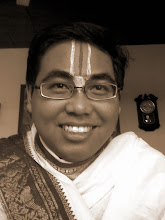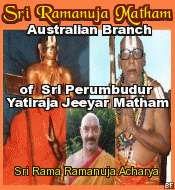 One inscription told us, “.... sira ta Sri Dharmavansha Anantavikramottungadeva ngaranira, umilwa manggalaning mangjawakna Byasamata... mwang parampara karengo tekeng anagatakala..., His Majesty named Sri Dharmavansha Anantavikramottungadeva, gave the order to bring auspiciousness by translating the sacred works of Vyasadeva to Javanese (mangjawaken Byasamata), ... so the valuable wealth of the divine disciplic succession (parampara) will continued to unlimited time in the future (anagatakala)”
One inscription told us, “.... sira ta Sri Dharmavansha Anantavikramottungadeva ngaranira, umilwa manggalaning mangjawakna Byasamata... mwang parampara karengo tekeng anagatakala..., His Majesty named Sri Dharmavansha Anantavikramottungadeva, gave the order to bring auspiciousness by translating the sacred works of Vyasadeva to Javanese (mangjawaken Byasamata), ... so the valuable wealth of the divine disciplic succession (parampara) will continued to unlimited time in the future (anagatakala)”Among 18 parvas of original Mahabharata, today we found Javanese (Kawi) translations of Adi Parva, Sabha Parva, Virata Parva, Udyoga Parva, Bhisma Parva, Ashramavasa Parva, Mausala Parva, Prasthanika Parva, Svargarohana Parva and some said the Vana Parva also available in Kawi. Other literary works also happened to be translated and compiled under patronage of Sri Dharmavansha, such as Uttara Kanda (from Valmiki Ramayana), Arjuna Vijaya, Astika-asraya (the story of how Astika Rishi saved the serpentine race from total annihilation by Maharaja Janamejaya’s sacrificial rites), Parthayana or Subhadra Vivaha (the marriage of Subhadra and Arjuna), Rama Kanda (summary of Ramayana), Hari-asraya, and Hari Vijaya (both about pastimes of Lord Krishna such as Kamsavadha, etc.).
We find no deviation or any significant difference between the stories of original Mahabharata with their Javanese translation of these several Parvas. This could be a little surprising if we read the older Yogisvara Ramayana. There are some differences with the original Valmiki Ramayana, though they are not so important. But when we read Javanese Ramayana, there is a strange feeling that The Lord’s pastimes were happened in Java itself rather than in India. We find the same case with Ramakien (Ramakhyan) of Siam or Thai Ramayana which said by some scholars was based on Javanese Yogisvara Ramayana. Both the Siamese and Javanese feel Ramayana was a part of their own mythological history. We don’t find such idea in the original translations of Mahabharata’s Parvas of Sri Dharmavansha’s reign. The deviations we find in today’s presentation of shadow puppet show (the Wayang) or its life drama was came from more recent interpolation and differentiated from the original translation of the Parvas by name Wayang Purwa.
Here we present some passages from Javanese Parvas (or let we called it Dharmavansha’s project) which glorified The Lord.
In Udyoga Parva, Duryodhana asked Sanjaya to reveal the true identities of Lord Krishna and Arjuna. Lord Vedavyasa appeared and told Sanjaya to say the truth, “aywa gigu mujarakena satuhunya (don’t hesitate, tell the truth)” Sanjaya then said, “Sajna haji, kadi ling patik haji nguni, tar keneng upalaksana kamahatmyan i sang Pandava, apan hana Maharaja Krishna ri sira. Maharaja Krishna ngaranira saksat Hari-murti, wenang sakala jagat wyapaka, siddha gawe wigraha. Icca nira ngkana ktang Triloka Mandala, mwang manahanakna. Sira humyang ing Bhur Bhuwah Swah. Sira suming ing catur yuga. Paramarthanya, sira wasitwa pramana ring sarwajanma, ndya ta marga sang Pandava tan lewiha? ~ Alright my lord, as my master said previously, actually I couldn’t describe properly the greatness (kamahatmyan) of the sons of Pandu. Since The King of all kings Lord Krishna was in their side. Verily, Lord Krishna was the Form of Godhead Himself (saksat hari-murti), He is omnipresent (wyapaka), and everything happened only out of His sanction. By His mere will, He created the whole three worlds and also destroys them. The Supreme Lord, worshiped by the inhabitants of Bhur, Bhuvah, and Suvah (upper, middle, and lower planetary system). He was the only Person glorified in four Yugas. He is the highest goal (parama-artha), by Whose will (wasitwa) all beings were born. So who could be better then the Pandavas?”

 We also find the crying of Draupadi, “trahi mam pundarikaksah, tatan hana sarana-asrayaning hulun waneh, tabeda sangke Parameswara ~ Protect me o My Lotus Eyed Lord, since I have no other place to surrender (sarana) and shelter (asraya), indeed You are The Supreme Godhead Himself.” In other place we have Kunti’s prayer, “Aum kaki Maharaja Krishna, kadina waneh mahanubhawaka, bheda saka ri tanayanku laki. Tvam dharma tvam tapo mahat. Kita marika dharma kita marika tapa. Tvam trata tvat parabrahma. Kita rakwasih satata. Kita nitya pinakatma mantra. Kalingannya tulusaken ta asih ta laki ri sanghulun kabeh. ~ Aum Maharaja Krishna my Son, there is no one more benevolent than You. (actually) You are different with my other sons (bheda saka ri tanayanku). You are dharma and the greatest tapa (the Cosmic Law and Penance). You are the maintainer of the whole creation and The Ultimate Truth. You always love us. Though You are the Eternal One (nitya) and the soul of all mantras. Please never cease to bestowing your love and affection toward all of us.”
We also find the crying of Draupadi, “trahi mam pundarikaksah, tatan hana sarana-asrayaning hulun waneh, tabeda sangke Parameswara ~ Protect me o My Lotus Eyed Lord, since I have no other place to surrender (sarana) and shelter (asraya), indeed You are The Supreme Godhead Himself.” In other place we have Kunti’s prayer, “Aum kaki Maharaja Krishna, kadina waneh mahanubhawaka, bheda saka ri tanayanku laki. Tvam dharma tvam tapo mahat. Kita marika dharma kita marika tapa. Tvam trata tvat parabrahma. Kita rakwasih satata. Kita nitya pinakatma mantra. Kalingannya tulusaken ta asih ta laki ri sanghulun kabeh. ~ Aum Maharaja Krishna my Son, there is no one more benevolent than You. (actually) You are different with my other sons (bheda saka ri tanayanku). You are dharma and the greatest tapa (the Cosmic Law and Penance). You are the maintainer of the whole creation and The Ultimate Truth. You always love us. Though You are the Eternal One (nitya) and the soul of all mantras. Please never cease to bestowing your love and affection toward all of us.”In Bhisma Parva we have the teachings of Dronacharya, when Yudhistira approached him at the beginning of the Great War. Drona said, “apa yan wibhrama dateng kari bapa? Tan enget karika kita? Yato dharmas tatha krishnas, yatah krishnas tatho jayah. Gengning punyantamarika an hana Maharaja Krishna iri kita. Hana ta Maharaja Krishna byakta hana ring kawijayan ri kita ~ What confusion (wibhrama) take you to approached me my son? Did you forget this? How great your virtue (punya) by having Lord Krishna in your side. Wherever the Truth (dharma) prevailed, then The Lord would be there. Wherever The Lord would be, then the supreme victory was assured.” At other place when Bhismadeva forced The Lord to take weapon and broke His vow to not involve at all in this war, except for gave advices and became Arjuna’s chariot-driver. For protection of His dear Arjuna, The Lord rushed to Bhismadeva and going to attacked him with a broken wheel of a chariot. In blissful mood Bhismadeva accepted his fatal fate by offering glorification unto The Lord, “tan wyabhicara keta sembahku ri kita, apan kita dewaning dewa, kita parameya… ~ I told You without any hesitation, please accept my obeisance Dear Lord, You O God of all gods, The Supreme…”
Under patronage of Sri Dharmavansha the Srimad Ramayana part of Uttara Kanda also translated once again to Javanese Kawi and highly elaborated the path of surrender (Saranagati), the core of Vaishnavite teachings. It was said as, “umilwa manggalya sarana-asrayaning ma sangkatha Sri Ramayana carita.”


































No comments:
Post a Comment